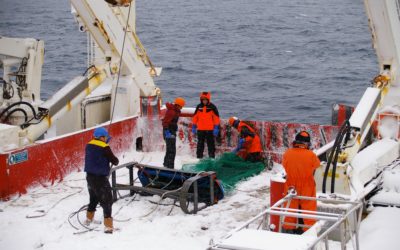Training in Norway
8 November, 2018 by Michael Gloistein
Ship Communication Officer tells us how the crew are preparing for their roles on board
The RRS Sir David Attenborough will have a critical operational role, supporting the resupply of British Antarctic Survey’s five Antarctic research stations.
RRS Sir David Attenborough‘s cargo hold has a volume of 2,100m³ and can store 660m³ of aviation fuel. The flexible design of the cargo hold means containers and other cargo can be stowed efficiently.
The ship is equipped with the following cranes to support logistics and scientific operations:
It is also equipped with a stern and a side A-frame (30t), a fold-out platform near the bow fitted with a boom and winch for towing scientific equipment and several removable bulwarks so equipment can be deployed from the aft deck.
The new polar ship has a workboat, Erebus, and cargo tender, Terror, which can approach Bird Island and Signy research stations during resupply operations. This is important because the water near these stations is too shallow for the ship to approach. There are also some small, inflatable craft aboard the ship.
In a nod to the history of UK polar exploration, Erebus and Terror are named after the ships from Sir John Franklin’s fateful exploration of the Northwest Passage – the sea route linking Europe and Asia through the Canadian Arctic – in 1845. Erebus was even built at the same yard as her namesake.

Erebus is a small, 10m research vessel that will enable scientists to carry out research in shallow, inshore waters, and transport people and supplies to and from our island stations.
She is fitted with a multi-frequency echosounder, for identifying and quantifying pelagic organisms; a shallow-water swatch bathymetry system, for mapping and imaging the seafloor; and a hydraulic stern davit and winch for sampling operations and deploying small equipment. Erebus can also support science diving operations.
The cargo tender will transfer supplies such as food, fuel and science equipment onto land at stations and places that the RRS Sir David Attenborough cannot access. To assist with this work, Terror is fitted with a crane that can lift up to 1t loads @ 8m.
The RRS Sir David Attenborough has a helideck and hangar which can support two small helicopters. These could assist with the deployment of airborne scientific instruments and scientific field parties, or transfer vital equipment to shore in case of fast ice preventing a landing by the ship.
Operating a polar research vessel with helicopter capabilities increases the potential science BAS and its collaborators can support.

8 November, 2018 by Michael Gloistein
Ship Communication Officer tells us how the crew are preparing for their roles on board
29 October, 2021
Explore polar science and engineering from your home with the Ice Worlds Festival online resources. On the eve of the UN COP26 climate talks in Glasgow, British Antarctic Survey has …
28 October, 2021
RRS Sir David Attenborough visits London as pre-COP event ahead of first mission to Antarctica. The UK’s new polar research ship is making its London debut in Greenwich (Thursday 28 October …
30 June, 2021
The RRS Sir David Attenborough (SDA) is getting ready for its next round of sea trials. This is an important part of the preparations for the ship’s first Antarctic mission. The …
26 September, 2019
The UK’s new polar research ship is formally named the RRS Sir David Attenborough today [Thursday 26 September] by the Duke and Duchess of Cambridge. In their first engagement of …
27 October, 2017
The RRS Sir David Attenborough (SDA) just got another step closer to completion as the Hamburg Ship Model Basin (HSVA) investigated the aerodynamic performance of Britain’s new polar research vessel using a computer generated ‘virtual wind tunnel’
18 August, 2017
A major feat of engineering takes place this week (21 August) as the “stern section” of the new polar research ship for Britain, the RRS Sir David Attenborough, is transported …
28 June, 2017
Researchers have captured unprecedented data about some of the coldest abyssal ocean waters on earth – known as Antarctic Bottom Water (AABW) – during the first voyage of the yellow …
7 April, 2017
The unmanned submersible Boaty McBoatface was deployed in the Antarctic for the first time.
![]()


